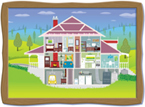
Air Sealing Tips
Weatherizing your home, sealing leaks and adding insulation, is one of the most cost effective ways to improve energy efficiency and comfort. Homeowners can save about ten percent of their total energy bills by sealing air leaks first, followed by adding insulation. You may save even more on your annual energy bills by completing an energy audit and making just some of the improvements identified in your home’s audit assessment.
Air leaks into and out of your home through every hole and crack. Many are easy to locate just by feeling the drafts around windows and doors. Hidden air leaks, such as holes in attics, basements and crawlspaces, are big energy wasters. Adding caulk and weatherstrip to all seams, cracks and openings to the outside can save you as much as 10 percent on your annual heating and cooling bills. .
Save Energy
Reduce the air leaks in your home by following these tips.
- Caulk and seal air leaks where plumbing, ductwork and wiring go through walls, ceilings and floors.
- Use sprayed or injected foam insulation to seal air leaks where plumbing and wiring enter insulated areas.
- Add foam gaskets behind outlet and switch plates on all exterior walls.
- Install storm windows or plastic window sheeting over single-pane windows.
- Look for dirty spots in your insulation to locate where air leaks in and out of your home. Seal holes with expanding foam or cover with plastic sheets and caulk around all edges.
- Sealing the connections and seams in your home’s ductwork with mastic or foil-backed tape will reduce leaks and make your home comfortable. If your home’s ductwork is located in unconditioned areas, such as the attic or unfinished basement, add duct insulation rated at R-6 or R-8.
- Seal all caps and cracks around the basement rim, or band, joists (where the house frame sits on top of the foundation).
- Keep the fireplace damper tightly closed when not in use.
Helpful Tools & Resources
courtesy of Energy Star
courtesy of Energy Star
- Guide to Energy Efficient Heating & Cooling
English (708KB)
(708KB)
Español (2.5MB)
(2.5MB) - Tips for Hiring a Heating and Cooling Contractor
- Duct Sealing brochure
 (1.13MB)
(1.13MB) - Maintenance Checklist

Cool Your World with ENERGY STAR @ home

Use the Home Energy Yardstick to
Measure Your Home's Performance

